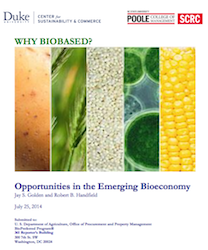The U.S. Department of Agriculture (USDA) has released a new report, “Why Biobased?” outlining current literature that explores opportunities in the emerging biobased economy. The report is a precursor for a more comprehensive economic study planned for release by the USDA BioPreferred program and will focus on the economic impacts of the biobased products industry.
 “This new report presents the opportunities U.S. agriculture and forests have in the emerging bioeconomy,” said USDA Secretary Tom Vilsack. “The recent inclusion of mature market products into the BioPreferred program strengthens our commitment to the U.S. biobased economy and brings together two of the most important economic engines for rural America: agriculture and manufacturing.”
“This new report presents the opportunities U.S. agriculture and forests have in the emerging bioeconomy,” said USDA Secretary Tom Vilsack. “The recent inclusion of mature market products into the BioPreferred program strengthens our commitment to the U.S. biobased economy and brings together two of the most important economic engines for rural America: agriculture and manufacturing.”
The new report explores how government policies and industry business-to-business sustainability programs are driving the biobased economy. The report also demonstrates that the biobased economy is, in fact, growing and it offers great potential for increased job creation in numerous sectors across the U.S. For instance, one report cited concludes that biobased chemicals are expected to constitute over 10 percent of the chemical market by 2015. Another report in the study concludes that there is a potential to produce two-thirds of the total volume of chemicals from biobased materials, representing over 50,000 products, a $1 trillion annual global market.
On the heels of this completed study, the USDA BioPreferred program has awarded a contract for a more in-depth economic study of biobased products and economic impacts, including research on job creation and economic value. It will be the first federally sponsored economic report of its kind targeting the biobased products industry in the U.S. Congress mandated the upcoming study in the 2014 Farm Bill.
The Biotechnology Industry Organization (BIO) has estimated that U.S.-based jobs for the renewable chemicals sector will rise from approximately 40,000 jobs in 2011, which represents 3-4 percent of all chemical sales, to over 237,000 jobs by 2025. This employment level would represent approximately 20 percent of total chemical sales.

